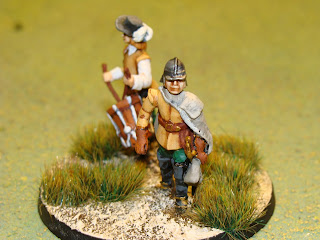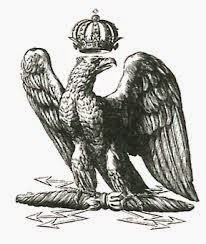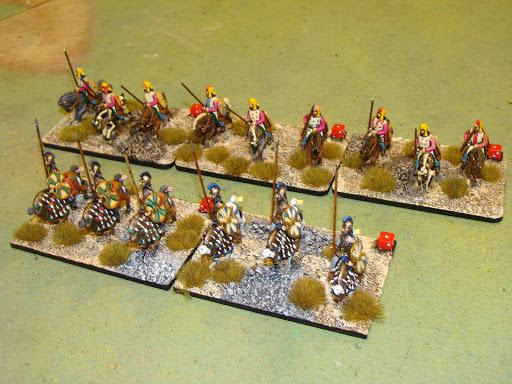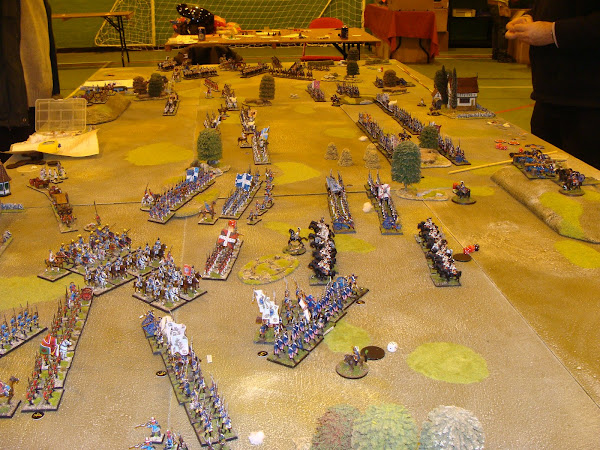
They may be old but are anatomically correct, a joy to paint and basically damned good figures. On the old Facebook one of my nemesi?? Ian Smith was taking the Michael out of me about all things nostalgic and he has a case in some aspects of the discussion, but these figures show why some old ranges deserve recognition.
After receiving my latest Miniature Wargames edition I was interested in the article by Conrad Kinch re the Waterloo Uncovered Project. This is the same group that staged the giant Battle of Waterloo wargame eons ago [last year]. I enjoyed the weekend and was naturally interested in the appeal that Conrad was making for contributors for their latest project.
James Cowan is a trustee of Waterloo
Uncovered, a charity that supports wounded ex-soldiers come to terms with their
conditions through the medium of archaeology. Every year, the charity
conducts a dig at Waterloo and, as well as uncovering new perspectives on the
battle, the many soldiers who attend enjoy being part of the project. In
the first few years, the focus was at Hougoumont but recently work has expanded
to other parts of the battlefield.
One of the techniques employed by Waterloo Uncovered has been to compare the
diorama built by Captain William Siborne with the modern archaeological
evidence. It occurred to James that it would be good to construct a new
diorama of the battle in homage to Siborne, but taking advantage of modern
scholarship. While Siborne’s work was pioneering for its time, much has
been learnt since. James had been collecting 20mm figures for many years
and had amassed around 40,000 metal and plastic soldiers. This was quite
a large number in its own right but nothing like the numbers needed to
replicate the battle at one to one scale. Given that the French started
the battle with 72,000, the Allies had 64,000 and Blucher brought about 40,000
of his Army onto the battlefield, this would require 176,000 figures. At
the rate he was painting (about a 1,000 a year) it would have taken James a
mere 136 years to complete the project.
This harsh reality caused a re-think! The first thing to do was to cut
numbers from one to one, to one to two-thirds and then to write down numbers
because of casualties. Once the extremities of the battlefield had been
removed, this reduced the requirement to a mere 100,000. Secondly, he has
been able to persuade two other major collectors to join the project and has
hopes others will do so as well; thirdly, he has increased production by
assembling an army of volunteer painters, each taking on a unit. James’s
father, Edward is an experienced model maker and has taken on the construction
of all buildings, producing 1/72 reproductions of Hougoumont, La Haie Sainte,
Papelotte, La Belle Alliance and Plancenoit.
In consequence, the model is growing very rapidly. The plan is to hold an
interim exhibition at the UK’s National Army Museum in June 2021. This is the
home of Siborne’s main diorama (a second one is in the Royal Armouries at
Leeds). Given the unfinished nature of the project and given the limited
space at the National Army Museum, the plan is to show various sections of the
battle, namely Hougoumont, La Haie Sainte, Papelotte, Plancenoit and La Belle
Alliance. In subsequent years, the main French cavalry attack, The Grand
Battery, and D’Erlon’s Corps will be added. Eventually, the full
battlefield will be shown on an area about the size of a tennis court, although
the actual shape resembles an octagon.
But while progress has increased dramatically, there is still plenty of room
for more volunteers. The attached spreadsheet shows completed units in
green and units underway in amber. We are looking for volunteers to
complete any of the units listed in red.
The diorama consists of a mixture of metal and plastic figures.
Figures are 1/72 or 20mm. Like all scales, this is a fairly
elastic term, varying in height from the smaller Newline (metal) and Airfix
(plastic), through to the larger Art Miniaturen (metal) and Zvezda (plastic).
15mm/18mm and 25mm/28mm figures are out of scope.
Painters are expected to be competent and capable of fine detail, but collector
standard is not required in these numbers. When sent in, figures should not be
attached to scenery but can be flocked. The finish should be matt
varnished, not gloss. Examples of work completed are in the attached pdf.
The team are also looking for collectors who have decided that there is no
point in their 20mm or 1/72 armies sitting in boxes in the attic and
would like to see their figures displayed in what will be the largest diorama
of its kind ever constructed. Once the work is done, contributors are
asked to accept that their figures become part of the diorama and cannot be
returned.
This chap is my sample figure to understand the issues etc for painting these figures. It is from the Italieri range and they are very nice to be honest if a little delicate.So I only need 18 boxes of them and a couple of jars of green etc. Hopefully I will be able to carry on painting my ancients etc in between all that green paint.

























